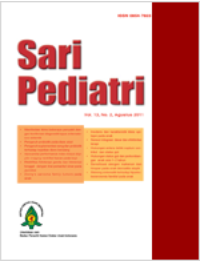Gigitan Ular Berbisa
Sari
Seorang anak laki-laki, usia 5 tahun 8 bulan dengan diagnosis gigitan ular dengan
compartement syndrome dan koagulasi intravaskular diseminata (KID) berdasarkan
identifikasi ular yang menggigit dan manifestasi klinis. Presentasi klinis terdiri dari tanda
bekas gigitan pada tungkai bawah kanan, rasa nyeri yang makin bertambah , bengkak,
ekimosis, bula, compartement syndrome, trombositopenia, anemia, PT, APTT yang
memanjang, dan d-dimer yang meningkat. Bila dilihat dari bentuk ular yang menggigit
dan manifestasi klinis yang timbul, yaitu bisa ular yang bersifat sitotoksik, ular yang
mengigit adalah famili Viperidae. Derajat berat kasus yang terjadi adalah derajat 4 (major),
karena terdapat tanda bekas gigitan, edem yang luas, serta KID.
Antibiotik diberikan juga kortikosteroid, bertujuan untuk mencegah efek samping
pemberian anti bisa ular. Fasciotomy dilakukan karena terdapat compartement syndrome
setelah itu pasien dirawat di ICU Anak untuk pemantauan lebih lanjut dan
mempersiapkan apabila diperlukan heparinisasi. Pasien dipulangkan dalam keadaan baik
setelah 3 minggu perawatan.
Kata Kunci
Teks Lengkap:
PDFReferensi
Holve S. Envenomation. Dalam: Behrman RE, Kliegman
RM, Jenson HB, penyunting. Nelson textbook of pediatrics.
Edisi ke-16. Philadelphia : WB Saunders company,
h. 2174-8.
Gold BS, Dart RC, Barish RA. Bites of venomous snakes.
N Engl J Med, 2002; 347:347-56.
Roberts JR, Otten EJ. Snakes. Dalam: Goldfrank LR,
Flomenbaum NE, Lewin NA, Weisman RS, Howland
MA, penyunting. Toxicologic emergencies. Edisi ke-4.
Connecticut: Prentice – Hall International Inc, 1990.
h. 789-99.
Dart RC, Seifert SA, Boyer LV, Clark RF, Hall E,
McKinney P, dkk. A randomized multicenter trial of
crotalinae polyvalent immune Fab (ovine) antivenom for
the treatment for crotaline snakebite in the Unites States.
Arch Intern Med 2001; 161:2030-6.
Malik GM. Snake bites in adults from the Asia region of
Southern Saudi Arabia. Am J Trop Med Hyg 1995;
:314-7.
Snyder CC, Mayer TA. Animal, snake, and insect bite.
Dalam: Matlak ME, Nixon GW, Walker ML, penyunting.
Emergency management of pediatric trauma. Edisi ke-1.
Philadelphia: WB Saunders Company. 1985. h. 466-83.
Boechat ALR, Paiva CS, Franca FO, Dos-Santos MC.
Heparin-antivenom association: differential neutralization
effectiveness in bothrops atrox and bothrops
erythromelas envenoming. Rev Inst Med trop S Paulo
; 43:1-16.
Young BA, Zatin K. Venom flow in rattlesnake: mechanics
and metering. J of Exp Biol 2001; 204:4345-51.
Thomas L, Tyburn B, Bucher B, Pecout F, Ketterle J, Rieux
D, dkk. Prevention of thromboses in human patients with
bothrops and anceolatus envenoming in martinique: Failure
of anticoagulants and efficacy of a monospecific
antivenom. Am J Trop Med Hyg 1995; 52:419-26.
Seneviratne U, Dissanayaka S. Neurological manifestation of snake bite in Sri Lanka. Journal of Postgraduate
Medicine 2002; 48:275-9.
Numeric P, Moravie V, Didier M, Chatot0Henry D,
Cirille S, Bucher B, dkk. Multiple cerebral infarctions
following a snikebite by bothrops caribbaeaus. Am J Trop
Med Hyg 2002; 67:287-8.
Lallo DG, Trevett AJ, Korinhona A, Nwokolo N,
Laurenson IF, Paul M, dkk. Snake bites by the papuan
taipan (Oxyuranus scutellatus canni): paralysis, hemostatic
and electracardiographic abnormalities, and effects
of antivenom. Am J Trop Med Hyg 1995; 52:525-31.
Boyer LV, Siefert SA, Clark RF, McNally JT, Williams
SR, Nordt SP, dkk. Recurrent and persistent coagulopathy
following pit viper envenomation. Arch Intern Med 1999;
:706-10.
Ramachandran S, Ganaikabahu B, Pushparajan K, Wijesekera
J. Electroencephalographic abnormalities in patients with
snake bites. Am J Trop Med Hyg 1995; 52:25-8.
Tun-Pe, Aye-Aye-Myint, Khin-Ei-han, Thi-Ha, Tin-Nu-
Swe. Local compression pads as a first-aid measure for
victims of bites by Russell’s viper (Daboia russelii
siamersis) in myanmar. Transactions of the Royal Soc of
Trop Med and Hyg 1945; 89:293-5.
Tun-Pe, Sann-Mya, Aye-Aye-Myint, Nu-Nu-Aung. Khin-
Aye-Kyu, Tin-Oo. Field trial of officacy of local compression
immobilization firts-aid technique in russell’s viper
(Daboia russelii siamensis) bite patients. Southeast As J
Trop Med Public Health 2000; 31:346-8.
Offerman SR, Smith TS, Derlet RW. Does the aggresive
use of polyvalent antivenin for rattlesnake bites result in
serious acute side effects ?. West J Med 2001; 175:88-91.
Premawardhena AP, de Silva CE, Fonseka MMD,
Gunatilake SB, de Silva HJ. Low dose subcutaneous
adrenalin to prevent acute adverse reaction to antivenon
serum in people bitten by snakes: randomised, placebo
controlled trial. BMJ 1999; 318:1041-3.
Hui Wen Fan, Marcopito LF, Cardoso JLC, Franca
FO, Malaque CMA, Ferrari RA, dkk. Sequential
randomised and double blind trial of promethazine
prophylaxis againts early anaphylactic reactions to
antivenom for bothrops snake bites. BMJ 1999;
:1451-3.
Blaylock RS. Antibiotic use and infection in snakebite
victims. South Afr Med 1999; 89:874-6.
DOI: http://dx.doi.org/10.14238/sp5.3.2003.92-8
Refbacks
- Saat ini tidak ada refbacks.
##submission.copyrightStatement##
##submission.license.cc.by-nc-sa4.footer##
Email: editorial [at] saripediatri.org


Sari Pediatri diterbitkan oleh Badan Penerbit Ikatan Dokter Anak Indonesia
Ciptaan disebarluaskan di bawah Lisensi Creative Commons Atribusi-NonKomersial-BerbagiSerupa 4.0 Internasional.




